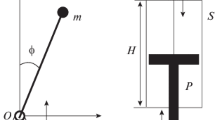Abstract
Systems with distributed parameters are considered, which are described by equations of the hyperbolic type. Controls represent distributed actions satisfying definite constraints and mobile actions that are both continuous and pulse excitations (actions). The problem is set out to find an instantly optimal control, i.e., such a control at which the rate of the energy change of the system at each instant takes on the highest value in absolute magnitude. It is proved that the instantly optimal control in the class of distributed controls is the mobile point control applied to the point at which the pulse density of the system reaches the highest value in absolute magnitude. Control algorithms are developed, which make it possible to reduce the amplitude of vibrations of the system and to increase it. Results of the numerical investigations of the developed algorithms are shown.
Similar content being viewed by others
References
Butkovskii, A.G. and Pustyl’nikov, L.M., Teoriya podvizhnogo upravleniya sistemami s raspredelennymi parametrami (The Theory of Mobile Control of Systems with Distributed Parameters), Moscow: Nauka, 1980.
Kubyshkin, V.A. and Finyagina, V.I., Podvizhnoe upravlenie v sistemakh s raspredelennymi parametrami (Mobile Control in Systems with Distributed Parameters), Moscow: SINTEG, 2005.
Kubyshkin, V.A, Optimal Mobile Controls in Closed Systems, Izv. Ross. Akad. Nauk, Teor. Sist. Upravlen., 1998, no. 6, pp. 78–85.
Utkin, V.I. and Orlov, Yu.V., Teoriya beskonechnomernykh system upravleniya na skol’zyashchikh rezhimakh (The Theory of Infinite-dimensional Systems of Control in Sliding Modes), Moscow: Nauka, 1990.
Komkov, V., Teoriya optimal’nogo upravleniya dempfirovaniem kolebanii prostykh uprugikh system (The Theory of Optimal Control for Damping of Vibrations of Simple Elastic Systems), Moscow: Mir, 1975.
Tikhonov, A.N. and Samarskii, A.A., Uravneniya matematicheskoi fiziki (Equations of Mathematical Physics), Moscow: Nauka, 1972.
Vladimirov, V.S., Uravneniya matematicheskoi fiziki (Equations ofMathematic Physics), Moscow: Nauka, 1972.
Fikhtengol’ts, G.M., Kurs differentsial’nogo i integral’nogo ischisleniya (The Course of Differential and Integral Calculus), Moscow: Gos. Izd. Tekhn.-Teor. Liter., 1949, vol. 2.
Author information
Authors and Affiliations
Additional information
Original Russian Text © V.A. Kubyshkin, 2011, published in Avtomatika i Telemekhanika, 2011, No. 10, pp. 117–128.
Rights and permissions
About this article
Cite this article
Kubyshkin, V.A. Mobile control of vibrations in systems with distributed parameters. Autom Remote Control 72, 2112–2122 (2011). https://doi.org/10.1134/S0005117911100109
Received:
Published:
Issue Date:
DOI: https://doi.org/10.1134/S0005117911100109




